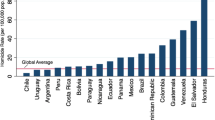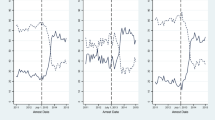Abstract
This paper examines the treatment effect of the justice reform enacted on January 1, 1995, in Virginia. Using FBI’s Uniform Crime Report data about crime rates per 100,000 population from 1960 to 2010, we find that after the reform the reported aggregated violent crime rate declined significantly and is mainly driven down by the decrease in robbery. We also consider property crime and find that the reported property crime rate does not decline until 4 years later, indicating that the justice reform in Virginia also has lagged treatment effect on property crime.

Source: Reentry Trends in The US, Bureau of Justice Statistics






Similar content being viewed by others
Notes
For details, the first chapter of Parole: Then & Now by Texas Senate Research Center provides an excellent reference.
Trends in State parole, 1990–2000, Bureau of Justice Statistics, 2001.
According to Virginia Department of Correction, mandatory parole is “the automatic release of an offender six months before completion of his or her sentence.” Unlike discretionary parole, parole board members might impose some special conditions for this type of parole but will not make the parole decision through voting.
Table 5 of Trends in State Parole, 1990–2000, Bureau of Justice Statistics, 2001.
Trends in State parole, 1990–2000, Bureau of Justice Statistics, 2001.
For details, see page 20, Chapter 2 of The Influences of Truth-in-Sentencing Reforms on Changes in States’ Sentencing Practices and Prison Populations.
Utah does not have Truth-in-Sentencing statutes but received federal grant funding on the basis of its Truth-in-Sentencing practices.
We have also used the AIC standard for state selections and actually get quite similar results. AICC is a more conservative model selection standard and prefers more parsimonious model. Thus, in the remaining part of the paper, the optimal models are all selected under AICC.
We thank one referee for pointing this out.
We thank a referee for the suggestion of conducting the add-covariates robustness check.
We thank one referee for pointing this out.
We thank one referee for pointing this out.
The sources of those data sets are FBI, Bureau of Labor Statistics and Census Bureau.
We thank one referee for pointing this out.
References
Abadie A (2005) Semiparametric difference-in-differences estimators. Rev Econ Stud 72:1–19
Abadie A, Diamond A, Hainmueller J (2010) Synthetic control methods for comparative case studies: estimating the effects California tobacco control program. J Am Stat Assoc 105:493–505
Athey S, Imbens G (2006) Identification and inference in nonlinear difference-in-differences models. Econometrica 74:431–497
Bai C, Li Q, Ouyang M (2014) Property taxes and home prices: a tale of two cities. J Econom 180:1–15
Dickey D, Fuller W (1981) Likelihood ratio statistics for autoregressive time series with a unit root. Econom 49(4):1057–1072. doi:10.2307/1912517
Hamilton J (1994) Time Series Analysis, Princeton University Press, 1st edn
Hsiao C, Steve Ching H, Wan S (2012) A panel data approach for program evaluation: measuring the benefits of political and economic integration of Hong Kong with mainland China. J Appl Econom 27:705–740
Kuziemko I (2013) How should inmates be released from prison? An assessment of parole versus fixed sentence regimes. Q J Econ 128:371–424
Levitt S (1996) The effect of prison population size on crime rates: evidence from prison overcrowding litigation. Q J Econ 111:319–351
Levitt S (1998) Why do increased arrest rates appear to reduce crime: Detterence, incapacitation, or measurement error? Econ Inq 36:353–372
Li K, Bell D (2017) Estimation of average treatment effects with panel data: asymptotic theory and implementation. J Econom 197:65–75
Li H, Lin W (2017) Estimating average treatment effects: a panel data approach by incorporating additional covariates. Unpublished manuscript
Marvell T, Moody C (1996) Specification problems, police levels and crime rates. Criminology 34:609–646
McPheters L, Mann R, Schlagenhauf D (1984) Economic response to a crime deterrence program: mandatory sentencing for robbery with a firearm. Econ Inq 22:550–570
Myers S (1980) The rehabilitation effect on punishment. Econ Inq 18:353–366
Sabol W, Rosich K, Kane K, Kirk D, Dubin G (2002) The influence of Truth-in-Sentencing reforms on changes in states’ sentencing practices and prison populations. Justice Policy Center of Urban Institute Washington, DC
Shafer JR (1999) The deterrent effects of three-strikes law. FBI Law Enforc Bull 68:6–10
Shepherd J (2002) Police, prosecutors, criminals, and determinate sentencing: the truth about truth-in-sentencing laws. J Law Econ 45:509–533
Sridharan S, Vujic S, Koopman S (2003) Intervention time series analysis of crime rates: the impact of sentence reforms in Virginia. Tinbergen Institute Discussion Paper
Author information
Authors and Affiliations
Corresponding author
Electronic supplementary material
Below is the link to the electronic supplementary material.
Rights and permissions
About this article
Cite this article
Li, Q., Long, W. Do parole abolition and Truth-in-Sentencing deter violent crimes in Virginia?. Empir Econ 55, 2027–2045 (2018). https://doi.org/10.1007/s00181-017-1332-4
Received:
Accepted:
Published:
Issue Date:
DOI: https://doi.org/10.1007/s00181-017-1332-4




